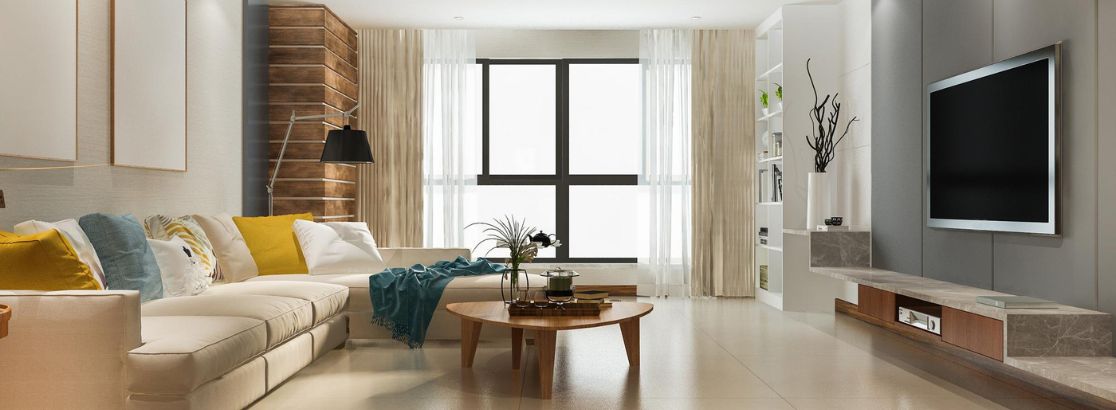

 By Raymond Realty
By Raymond Realty  January 6, 2025
January 6, 2025  Blog
Blog

When you buy, sell or invest in a property, you do a lot of research, as you need to understand all the basic real estate terms. Carpet area, Built-up area, and super built-up area are three such terms that help in determining property pricing, usability and overall value.
Many buyers don’t pay attention to this when they buy a flat or home, and this leads to a lot of confusion. This mostly happens as many don’t know what is built-up and carpet area.
In this blog, we will understand more about these three, how they are calculated and how they are different from each other. So read on to find out what is a super built-up area, and how you can find the number by doing some simple math!
Let’s start!
The carpet area is basically the area of the flat or house where you can lay a carpet. This is only the floor area of the halls, rooms and kitchen; the walls, balconies and utility are not included in it.
Real-life implications for homebuyers:
For example, a flat advertised to be 1000 sq. ft., may actually have a carpet area of only 700 sq. ft., which means that only 70% of the space is usable.
The formula for carpet area is pretty simple:
Carpet Area = Total Floor Area – Thickness of the internal walls.
Let’s take an example calculation:
Say, the total floor area of a master bedroom in a flat = 500 sq. ft.
And the combined thickness of the internal walls = 50 sq. ft.
Using the formula,
Carpet area = 500 – 50 sq. ft.
So, the carpet area of the bedroom is 450 sq. ft.
Here are some ways in which the carpet area can be calculated without the formula:
The carpet area is more important than the super built-up area:
Key Insight: Always focus on the carpet area while evaluating the property’s value, as it reflects the space you will be living in.
The built-up area of a property is the carpet area, plus the thickness of the external and internal walls, and the additional spaces like the balcony, terrace and utility area.
So, the components of the built-up area include:
The built-up area could be 15 to 25% larger than the carpet area, depending on the walls’ thickness and design layout.
The built-up area is also very easy to find:
Built-up area = Carpet Area + Wall Thickness + Balconies.
Let’s take an example calculation:
If the carpet area is 700 sq. ft.,
Internal and External Walls is 100 sq. ft., and the balcony is 50 sq. ft.,
Using the formula,
Built-up area = 700 +100 +50
Built-up area = 850 sq. ft.
However, many times, mistakes are made when calculating for this number:
Role in Construction Costs:
The built-up area often influences construction expenses, since it includes walls, balconies and other semi-usable spaces. Many real estate developers determine their properties’ prices based on this number, as it reflects the total coverage for construction.
Usable v/s Unusable Space:
Always remember to check the carpet-to-built-up area ratio so that you know that the space you are paying for is worth it.
Differences between the carpet area and the built-up area are:
| Feature | Carpet Area | Built-up Area |
| Definition | Usable floor space | Carpet area + wall thickness + balcony. |
| Includes | Bedrooms, living rooms and kitchen | Walls, balconies and utility areas |
| Excludes | Walls, balconies and terraces | External walls and common areas |
| Usability | Fully usable | Partly usable |
| Price Impact | Lower costs | Higher costs due to added spaces. |
Real World Implications:
The super built-up area is usually determined by the builder and has the built-up area, with a proportionate share of common areas, like the lobbies, staircase, elevators and amenities, So the developer determines this number and markets their projects based on it.
The super built-up area includes:
Finding the super built-up area is pretty easy. Here is the formula:
Super built-up area = Built-up area + Proportionate share of common areas.
Here is a step-by-step guide on how you can calculate the super built-up area using the formula:
Step 1: Find the built-up area.
The built-up area of the apartment is the carpet area, walls and balcony spaces. Let’s assume that this particular flat’s built-up area is 1000 sq. ft.
Step 2: What’s the total common area?
It’s the total area of shared spaces like lobbies, corridors, lifts and clubhouses in the building. Now we assume that this is 10,000 sq. ft shared by 50 flats.
Step 3: Calculate the Proportionate Common Area.
So now, every flat gets a share of the common area, based on the total number of apartments.
Proportionate Common Area = Total Common Area/Total Number of Apartments.
Substituting the values, we have:
PCA = 10,000/50
PCA = 200.
Step 4: Use the formula to find the super built-up area.
Super built-up area = Built-up area + Proportionate share of common areas.
= 1000 + 200
= 1200 sq. ft.
Thus, the super built-up area is 1200 sq. ft.
This is a very simple way of finding this number, as developers do it differently:
Connection with Amenities and Property Value:
As a buyer, make sure you look for these so that you don’t end up paying extra for space you won’t get to use.
According to RERA, the loading factor is a percentage that denotes how much additional area has been charged to the buyer and covers the non-usable spaces like walls and common areas.
How is the loading factor used in the real estate sector?
Builders often apply the loading factor to the carpet area, to calculate the super built-up area.
A high loading factor will lead to higher costs while offering less usable space.
In India, the average loading factors vary from city to city. For example:
Metro Cities: 30 to 50%, as most residential projects have larger shared amenities.
Smaller Towns or Rural Areas: 20 to 30%, since shared spaces and amenities are limited in these areas.
The formula for calculating the loading factor is:
Loading Factor = [Super Built-Up Area – Carpet Area/Carpet Area] x 100.
Here is an example calculation:
Say the super built-up area = 1200 sq. ft.
Carpet area = 800 sq. ft.
Applying the formula, we get:
Loading Factor = [Super Built-Up Area – Carpet Area/Carpet Area] x 100.
LF = [1200 – 800/800] x 100
LF = 50%
This means that 50% of the carpet area is added as loading to get the super built-up area.
The loading factor plays an important role in real estate, helping buyers make informed buying decisions.
Impact on Usable Space:
While buying, you need to negotiate with the developer for the following information:
So, are there any differences between built-up area and super built-up area? Here are four ways how:
| Aspect | Built-up Areas | Super Built-up Areas |
| Definition | Carpet Area + Walls +Balconies | Built-up area + Proportionate common areas |
| Includes | Walls, balconies and utility areas | Lobbies, corridors and amenities. |
| Impact on costs | Direct construction costs | Inflated price per sq. ft. |
| Usability | Partially usable | Includes shared spaces. |
Always review the floor plans to clear up any confusion regarding these differences.
Here is a checklist you can follow while evaluating the property:
Make sure that you understand the definitions and calculations of carpet, built-up and super built-up areas, to help make informed decisions. Knowing what they mean will empower you, and help you negotiate better, preventing any confusion while assessing the property.
If you are ever confused about all three definitions and want detailed information about them, then use this guide to clarify property choices and ensure that your investment is given a fair value!